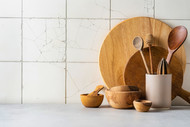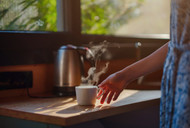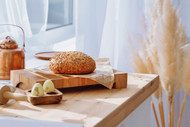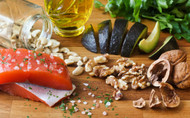
How to Clean Your Wood Cutting Boards: 5 Effective Tips
Jan 23rd 2020
The cutting board is an essential kitchen tool – used for everything from chopping and dicing to serving. Wooden cutting boards offer benefits beyond their beauty: they’re food safe, gentle on knives, and durable. But they do require consistent care to last.
If the thought of caring for your cutting board is daunting, don’t worry! These easy-to-follow tips will make cleaning your wood cutting board simple.
Basic Wooden Cutting Board Cleaning & Care
Wood cutting boards require regular cleaning and care but the good news is that it’s actually really easy to do. And if you do it, your cutting board can last for many years.
Here Are the Cleaning Basics:
- Start by cleaning your wood cutting board with soap and warm water to remove surface dirt and residue. Use a soft cleaning sponge or cloth.
- Disinfect the board using natural solutions like white vinegar to kill bacteria. Avoid harsh chemicals like bleach, they can discolor wood.
- For tough stains, apply a paste of baking soda and water, then scrub gently.
- Remove lingering odors by rubbing the board with a mixture of baking soda and vinegar, or by using a cut lemon.
- Preserve the board's condition by applying a thin layer of food-grade mineral oil after cleaning
That’s all there is to it! Your cutting board is clean and ready to dry!
Cutting Board Cleaning Do's & Don'ts
Here are some additional do's and don'ts for cleaning wood cutting boards.
| Cutting Board Cleaning Do's | Cutting Board Cleaning Don'ts |
|
|
Advanced Cutting Board Care Tips
To get the most from your cutting board and extend its life, be sure to occasionally follow these advanced care tips.
Sanding Out Cuts & Scratches
Over time, your wood cutting board will accumulate scratches. This is normal wear and tear. It’s important to periodically resurface your cutting board with light sanding. Follow these steps to remove small scratches:
- Clean the Board: Make sure it's clean and dry.
- Select Sandpaper: Start with a coarse grit (e.g., 80-100) for deep scratches, then use finer grits (e.g., 220, then 320) to smooth the surface.
- Sand Evenly: Sand in the direction of the grain to avoid additional scratches.
- Check Progress: Frequently check if scratches are diminishing; stop when satisfied.
- Clean Again: Remove all dust with a damp cloth.
- Condition: Apply food-grade mineral oil and/or beeswax to rehydrate and protect the wood.
Keeping your cutting board oiled and waxed will help diminish smaller scratches and cuts by providing a protective layer on top of the surface.
Applying Wax
Wax helps preserve wood cutting boards by creating a protective barrier that repels water and prevents moisture absorption, which can lead to warping, cracking, and bacteria growth. Be sure to use a food safe wax, preferably beeswax-based, and follow these steps:
- Clean the Board: Ensure the cutting board is clean and dry.
- Apply Wax: Use a clean cloth to apply a small amount of board wax evenly.
- Rub in Circles: Work the wax into the wood in circular motions.
- Let Sit: Allow the wax to penetrate the wood for a few minutes.
- Buff: With a clean cloth, buff the board to a shine.
- Repeat As Needed: Re-wax as needed to maintain protection and luster.
For detailed instructions, it's best to consult the product guidelines of the specific wax you're using or visit woodworking resources.
Inspecting Your Cutting Board & Repairing Small Cracks
Exceptionally dry wood cutting boards may crack if left untreated. If you practice regular cleaning and care, cracks are rare; however, here’s what to do to find and treat cracks:
- Inspect Under Good Lighting: Check all surfaces and edges for cracks.
- Sand Out Small Cracks: Use fine-grit sandpaper for minor imperfections.
- Fill Deeper Cracks: Apply a food-safe wood filler if needed.
- Clean Thoroughly: After repairs, clean the board well.
- Dry Completely: Ensure the board is fully dry before the next step.
- Recondition: Apply food-grade mineral oil followed by a beeswax-based conditioner.
Why Should You Clean Your Wood Cutting Boards?
There are several reasons why you should regularly clean your wood cutting boards. One of the main reasons is that cleaning helps your cutting boards avoid damage and maximizes their lifespan. If our hardwood cutting boards are maintained they can last for years and years as a trusty tool in your kitchen. Failing to clean your cutting board with leave it quickly damaged and worn out.
Cleaning also removes any bacteria, food particles, and other materials left from food preparation. Removing these substances helps reduce the risk of cross-contamination and foodborne illnesses.





